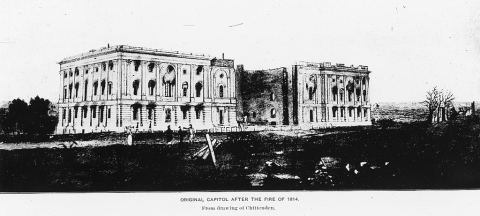Burning the Capitol: what really happened during the War of 1812
Posted on August 22By: Office of the A...

Categories:
|
Drawing of the U.S. Capitol as it appeared in 1814 before the fire set to the building by the British in that same year. |
At the time the Capitol was still being constructed and consisted of only the north and south wings connected by a wooden walkway spanning the area intended for the center building. Damage to the wings was severe, but due in part to the fire-proof building materials and techniques employed by architect Benjamin Henry Latrobe, the exterior structure survived and many of the interior spaces remained intact.
The British focused their destructive work on the principal rooms, foregoing the lobbies, halls, and staircases in an effort to inflict the most demoralizing wound on the Americans while preserving their own escape route from the burning building. In the south wing, soldiers ignited a giant bonfire of furniture slathered with gunpowder paste in the Hall of the House of Representatives (now National Statuary Hall). The heat from the fire grew so intense that it melted the glass skylights and destroyed many of the stone carvings in the room, including a colossal marble seated figure of Liberty by Giuseppe Franzoni located above the Speaker's rostrum. Downstairs, the Clerk's office was transformed into an inferno of burning documents and furniture; this fire produced a heat so great it forced the British to retreat from the south wing, leaving half of the rooms on the first floor unscathed.
In the Supreme Court Chamber, on the first floor of the north wing, troops piled furniture from nearby rooms to create another great bonfire, severely damaging the Doric stone columns. Upstairs – in a grand room that then housed the Library of Congress' collection of over 3,000 documents – served as a ready stockpile of fuel. The space burned so fiercely it endangered a portion of the exterior stone wall. From the library, winds spread the flames to the Senate Chamber, where the damage to the art and architecture was also severe. In a letter to Thomas Jefferson after the fire, Latrobe described the Capitol as a "most magnificent ruin."
Today, to see areas of the building that survived the fire, make your way to the Small House Rotunda on the second floor of the Capitol and look at the Corinthian columns adorned with water leaves, designed by Latrobe and installed in 1807. Then, head across the Rotunda and down the stairs to the east vestibule on the first floor of the north wing, where the architect's "corn cob" columns still stand 203 years after being installed. It was through the original door of this domed vestibule that the British fled the burning building into the night.








Leave a comment